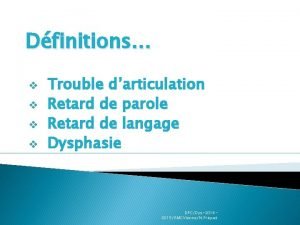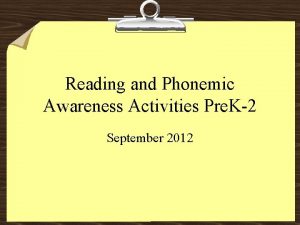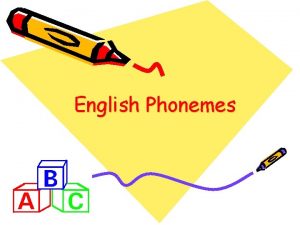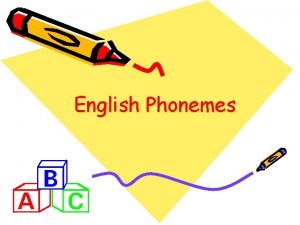Slide 1 Ch 3 More on Phonemes Is









- Slides: 9

Slide 1 Ch 3 – More on Phonemes • Is there a connection between phonemes and speakers’ perception of phonetic differences? (audibility of fine distinctions) • Due to phonology, we have a limited ability to perceive fine phonetic distinctions that for us, are allophonic, while for others, they are phonemic. That is, even when speakers produce a particular phone/sound, if it is an allophone of another phoneme, then it is difficult for them to perceive the differences between 2 sounds. • Dental versus alveolar stops example p. 49 • Mid and Low back vowels – cot vs. caught

Slide 2 Ch 3 – More on Phonemes • By 10 months, we only distinguish between sounds that are phonemic, although it is suggested that when we are born, we can distinguish between any possible sound • “Native speakers hear the differences between phonemes, but not between allophones. ” (p. 50) (notion of same sound) • Speakers usually believe that allophones of 1 phoneme are the same sound despite phonetic diffs. • French vs. English nasalized vowels. P. 51 (also rounded/unrounded vowels in lang with a phonemic distinction vs. Eng) • “once speakers have been made aware of the existence of speech sounds in their language, they will naturally tend to consider allophones of the same phoneme as counting as the same sound. ” (p. 52)

Slide 3 Ch 3 – More on Phonemes • Speakers internalize rules that derive the various allophones in their appropriate environments. (foreign accents and transfer) • Foreign accents are not just missing the mark of the target language, but rather transference of the phonological rules from L 1 into L 2 • Phonologically illegal because the phoneme is illegal (it doesn’t exist in L 1) – non Eng phonemes like voiced uvular fricative • Phonologically illegal because the sequence is illegal (order doesn’t exist in L 1 although the phonemes might) – [bnik] • Phonologically illegal because corresponds to impossible distribution of allophones (it doesn’t follow rules of English allophones) – [fil] with nonvelarized [l] or [pit] with non-aspirated [p]

Slide 4 Ch 3 – More on Phonemes • Phonetic similarity – when we are looking at allophones of a phoneme, we should find some phonetic similarity between the allophones. • For example, in the Lango hw (Ch 2 ex 2) exercise, we could say that [p] and [x] are allophones of the same phoneme since they are in complementary distribution, but instead we choose [x] as an allophone of /k/ since that makes more phonetic sense (there are more phonetic similarities between the velars)

Slide 5 Ch 3 – More on Phonemes • Contour segments – phonology is all about how sounds are behaving with respect to other sounds. So in English, it makes more sense to consider the affricates a single phonological entity since they BEHAVE like one rather than a sequence of 2 segments. • Contrast cats with catch both ending in stop + fric (phonetically could call them both affricates)

Slide 6 Ch 3 – More on Phonemes • Borrowed sounds – book discusses Japanese as did we in class. If borrowing results in the breaking of allophonic rules and creates a minimal pair, then we have to evaluate if that means the language has a new phoneme, or if we need to qualify this phenomenon within certain vocabulary level constraints – that is, if this only happens with borrowed words and hasn’t spread to “native” vocabulary, then what can we say about phonological rules?

Slide 7 Ch 3 – More on Phonemes • Free Variation – (sociolinguists hate this term because the free is really limited to linguistic constraints (or lack thereof) rather than social ones) • Great discussion of optional rules (rules that apply sometimes for a single speaker). Sometimes these are what sociolinguists call variable rules (usually a quantifiable amount or frequency of how often a rule does or does not apply). • Dialect/Language differences – an optional rule can be obligatory for some and optional for others (and vice versa) • Sometimes optional rules come out as a difference in speech styles – this leads to elicitation issues (which sociolinguists and formal linguists differ on).

Ch 3 Slide 8 Ch 3 – More on Phonemes • Contextually limited contrasts – sometimes a rule can apply in a limited environment or context • Toba Batak example – final voiced stops are devoiced (final obstruent devoicing is common in many languages so watch out for this in data!!!) • Either see this as a rule: [+stop] [-voice] / ___ # • OR as a constraint: *[+stop] / ___ # [+voice] • Some use both constraints and rules, others use on or the other. • Phonotactic constraints are those that allow certain segments in certain environments or sequences

Slide 9 Ch 3 – More on Phonemes • Contrasts with zero • C Ø / C __ # • *CC / __ # • Trouble with constraint is why is the last consonant deleted rather than the first?
















